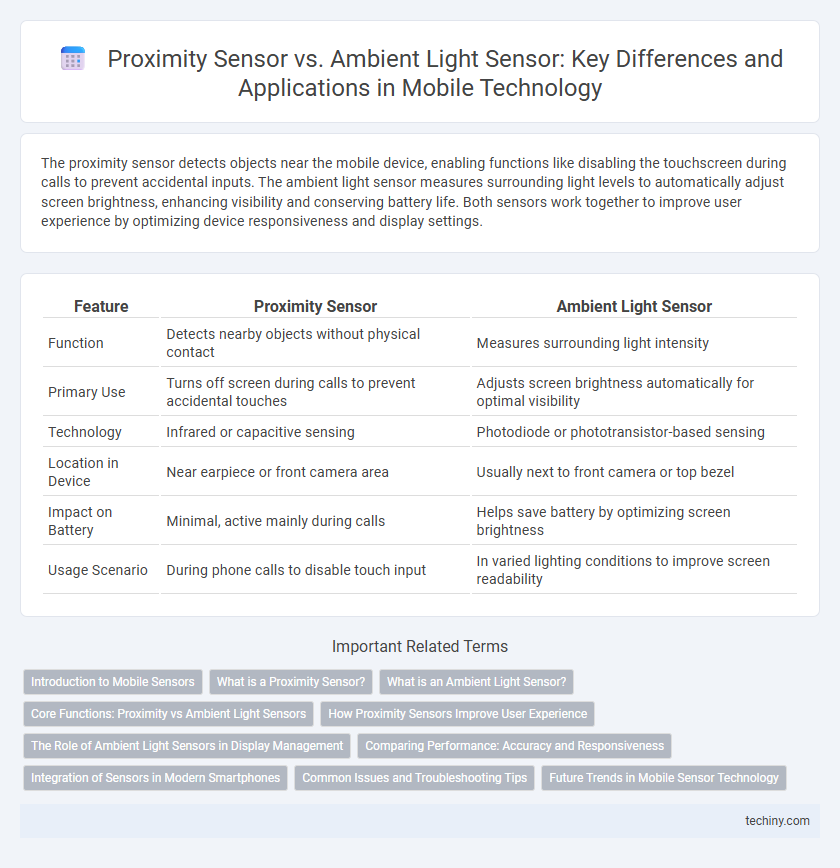The proximity sensor detects objects near the mobile device, enabling functions like disabling the touchscreen during calls to prevent accidental inputs. The ambient light sensor measures surrounding light levels to automatically adjust screen brightness, enhancing visibility and conserving battery life. Both sensors work together to improve user experience by optimizing device responsiveness and display settings.
Table of Comparison
| Feature | Proximity Sensor | Ambient Light Sensor |
|---|---|---|
| Function | Detects nearby objects without physical contact | Measures surrounding light intensity |
| Primary Use | Turns off screen during calls to prevent accidental touches | Adjusts screen brightness automatically for optimal visibility |
| Technology | Infrared or capacitive sensing | Photodiode or phototransistor-based sensing |
| Location in Device | Near earpiece or front camera area | Usually next to front camera or top bezel |
| Impact on Battery | Minimal, active mainly during calls | Helps save battery by optimizing screen brightness |
| Usage Scenario | During phone calls to disable touch input | In varied lighting conditions to improve screen readability |
Introduction to Mobile Sensors
Proximity sensors detect the presence of nearby objects without physical contact, primarily used to turn off the display during calls to conserve battery and prevent accidental touches. Ambient light sensors measure environmental light levels to automatically adjust screen brightness, enhancing visibility and reducing eye strain. Both sensors are integral to mobile technology, improving user experience through adaptive and context-aware device behavior.
What is a Proximity Sensor?
A proximity sensor in mobile technology detects the presence of nearby objects without physical contact by emitting electromagnetic fields or infrared signals. It primarily prevents accidental screen touches by disabling the touchscreen when the device is close to a user's face during calls. Unlike ambient light sensors that adjust screen brightness based on environmental lighting, proximity sensors enhance usability and conserve battery life by managing screen activity in proximity scenarios.
What is an Ambient Light Sensor?
An ambient light sensor detects the intensity of surrounding light to adjust screen brightness automatically, enhancing user comfort and conserving battery life in mobile devices. It uses photodiodes or phototransistors to measure ambient illumination levels, enabling adaptive display settings based on environmental lighting conditions. This sensor plays a crucial role in improving visibility and energy efficiency in smartphones and tablets.
Core Functions: Proximity vs Ambient Light Sensors
Proximity sensors detect the presence of nearby objects without physical contact, primarily used for functions like turning off the screen during calls to prevent accidental touches. Ambient light sensors measure surrounding light levels to automatically adjust screen brightness, enhancing visibility and conserving battery life. Both sensors play crucial roles in optimizing user experience by adapting device behavior based on environmental conditions.
How Proximity Sensors Improve User Experience
Proximity sensors enhance user experience by detecting the presence of nearby objects to automatically disable touchscreen inputs during calls, preventing accidental touches. These sensors also contribute to power saving by turning off the display when the device is held close to the face, extending battery life. Unlike ambient light sensors that adjust screen brightness based on environmental lighting, proximity sensors focus on interaction-based functionality, improving device usability and efficiency.
The Role of Ambient Light Sensors in Display Management
Ambient light sensors play a critical role in display management by automatically adjusting screen brightness to optimize visibility and conserve battery life. These sensors detect surrounding light levels, allowing devices to adapt the display intensity for comfortable viewing in various environments. Unlike proximity sensors that detect object presence, ambient light sensors enhance user experience through dynamic brightness control.
Comparing Performance: Accuracy and Responsiveness
Proximity sensors typically measure object distance with high accuracy using infrared or ultrasonic signals, providing rapid response times essential for screen on/off functionality during calls. Ambient light sensors detect environmental illumination levels via photodiodes, delivering precise real-time adjustments to screen brightness for optimal visibility and power efficiency. While proximity sensors excel in quick detection of nearby objects, ambient light sensors prioritize sensitivity to light changes, resulting in differing performance metrics tailored to their specific roles in mobile devices.
Integration of Sensors in Modern Smartphones
Modern smartphones integrate proximity sensors and ambient light sensors to enhance user experience by optimizing screen behavior and power consumption. Proximity sensors detect the presence of objects near the device, enabling features like automatic screen lock during calls, while ambient light sensors adjust screen brightness based on surrounding light conditions for energy efficiency. Combining these sensors leverages complementary data, improving device responsiveness and battery performance in diverse environments.
Common Issues and Troubleshooting Tips
Proximity sensors often face issues with false triggers caused by dirt or screen protectors blocking the sensor, while ambient light sensors may struggle with inaccurate brightness adjustments due to dust accumulation or software glitches. Troubleshooting proximity sensor problems involves cleaning the sensor area and recalibrating through device settings, whereas resolving ambient light sensor issues typically requires removing obstructions, updating firmware, or performing a factory reset to restore sensor accuracy. Both sensors benefit from regular maintenance and software updates to ensure optimal functionality in mobile devices.
Future Trends in Mobile Sensor Technology
Proximity sensors in mobile devices will evolve with enhanced accuracy and lower power consumption, enabling more intuitive user interactions such as advanced gesture controls and secure device locking. Ambient light sensors are expected to become more sensitive and adaptive, optimizing screen brightness dynamically to improve battery life and user comfort in varied lighting conditions. Future trends indicate the integration of these sensors with AI algorithms for smarter environmental awareness and personalized user experiences in smartphones and wearable devices.
Proximity Sensor vs Ambient Light Sensor Infographic

 techiny.com
techiny.com